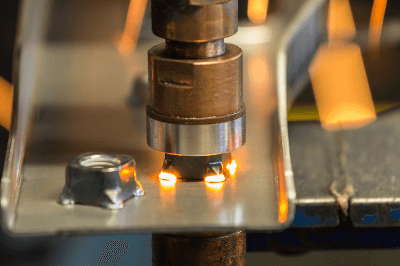What Is a Weld Nut?
 A Weld Nut is a nut with a protruding “pilot” shape that is welded into place.
A Weld Nut is a nut with a protruding “pilot” shape that is welded into place.
There are several types of Weld Nuts, each with a different number of corners and shape, so it is important to select the right one for the application.
Uses of Weld Nuts
Weld Nuts are mainly used in products made of multiple thin metal sheets such as home appliances, 2-wheelers, 4-wheelers, and parts for golf clubs. When securing bolt fastening torque, at least 5 pitches are required between the bolt and nut threads to prevent loosening.
Since 1.5 mm threads are generally used per pitch, the thickness of the metal plate must be at least 7.5 mm to set the taps for bolt fastening on the metal plate. Therefore, since taps cannot be cut on metal sheets thinner than 7 mm, Weld Nuts are used to secure the threads and provide a connection point for bolt fastening on the thin sheet.
In addition, when using Weld Nuts, metal plates are not welded to each other, so they can be easily removed and attached, and many Weld Nuts are used for structures with large sizes.
Principle of Weld Nut
Weld Nuts are held in place by a welding pilot, which is a welding projection provided on the nut that is welded to the base metal. This pilot is the most distinctive feature of the Weld Nut and plays an important role.
The pilot is a protruding shape designed to reduce the contact area with the base metal and to facilitate pinpoint temperature rise only in the pilot area during welding. The shape of the pilot also serves to position the nut.
Some types of Weld Nuts do not have a pilot, and are generally joined to the base metal by projection welding if they have a pilot, or by arc welding if they do not.
Types of Weld Nuts
There are three main types of Weld Nut:
1. Hexagonal Weld Nut
Hexagonal weld nuts are hexagonal in shape, with three protrusions in each of the six corners as pilots for welding to the metal plate. The advantage of the hexagonal type is that welding work is easy to perform because there are few welding points. On the other hand, the disadvantage is that the strength of the joint is inferior to other types because the joint with the metal plate is limited to three points.
2. Square Weld Nut
The square type is square in shape and the pilot is set at all four corners, so all four points are welded to the metal plate. The four welding points provide a stronger joint than the hexagonal type, which has three welding points, and thus higher torque can be applied. The square type is most commonly used in automobiles.
3. T Type Weld Nut
The T-shape is flanged at the nut, which allows for a larger welding area and thus a stronger joint. On the other hand, its disadvantage is that the welding time is longer than that of other nuts.
Other Information on Well Nut
Advantages of Weld Nuts
By welding Weld Nut, the pilot that the nut has and the base material are welded together and secured. Since they are joined by welding, the joint is highly stable and strong.
Weld Nuts are mainly used when the base metal plate is too thin to allow tapping for bolts. For example, when the thickness of an automobile body shell is only 1 to 2 mm, the metal plate is too thin to secure threads even if tapping for bolts is performed.
By installing a Weld Nut in such a situation, it is possible to provide threads only in the area where the bolt fastening is desired, without changing the thickness of the entire metal plate. Another advantage is that because nuts are used, removal after welding is easier than spot welding, in which metal plates are joined by overlapping each other.